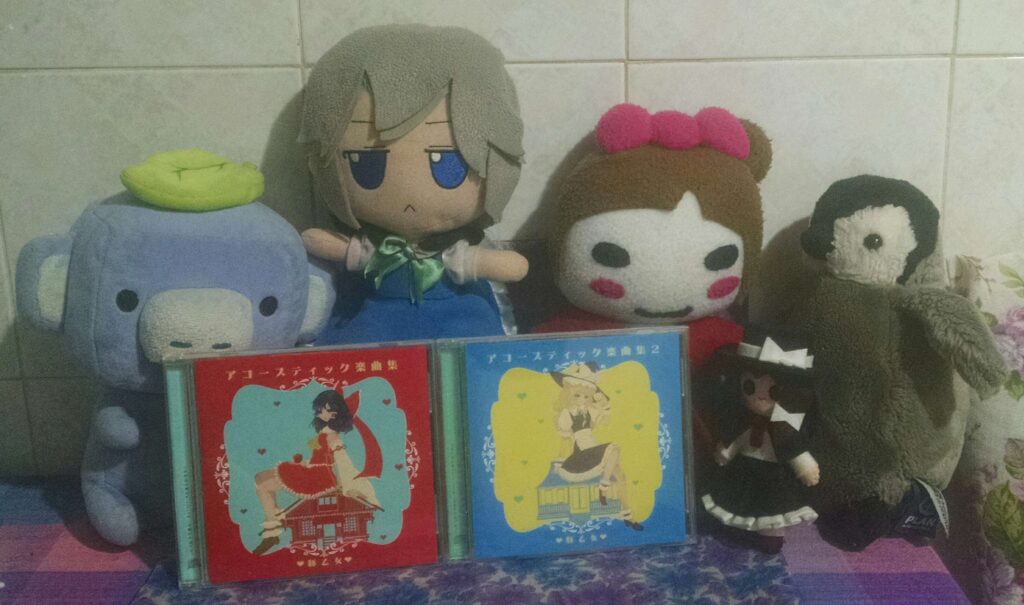
This article was originally meant to be a celebration for the 10th anniversary of a certain thing. However, as I was writing it, I decided to put some things in a separated post that I will publish next week. So, for today, you are going to get a pure and simple review, that rescues some old notes and drafts I wrote in the past.
The beauty of re-arrangements
Re-arrangements are a great way to give new life and different interpretations to an old song. They are also a good way to have a song about character x in an album, without thinking too much about something new. And sometimes we have arrangements that are miles better than the original song (hi, hi). The rearrangement albums section in the BUTAOTOME discography has quite a few entries. There is Neko no Anmin, which was great, but I’d rather talk about it whenever I’ll get back to that Nekokenban retrospective. Then, there is the Guerrilla duology, which was pretty good overall (not a huge fan of the second one for reasons I’ll explain later). And then there are Retake+ and the two Piano to Utas, which… ah. Yeah, they exist. Last but not least, we have my favorite rearrange albums and the protagonists of today’s review: the two Acoustic Gakkyokushuus.
To start, I want to talk about the things these two albums have in common: they are BUTAOTOME re-arrange albums released in 2014, they have the same title, six tracks, and have very similar elements of design. They also both have a Marisa song and a Hifuu one. …Yeah.
By the way, best of/re-arrange albums tend to have a much simpler design with a major focus on having a pretty cover over having extra stuff, but these two albums are pretty nice to look at. Reimu and Marisa kinda look like dolls, and their eyes remind me of Takatora‘s artstyle! The apple and the lemon on their hand and on the disc label are also fun details – their colors can be easily associated with Reimu and Marisa, although apples in Touhou are often a synonym for awful things.
Nostalgic Music Collection
The first Acoustic Gakkyokushuu was released on February 2014, during a time when BUTAOTOME had a weekly livestream where they played short acoustic versions of their songs. I see this album as a relic from that era since the rearrangements here are in that same style. Just Comp playing the guitar, Paprika playing the piano and Ranko singing. Simple is best!
The arrangements work very well – some tracks such as Chigirizake and Yume janai Nanika somewhat keep the original energy, but my favorite track is Kakoinaki yo wa Ichigo no Tsukikage. Its calmer atmosphere is perfect for clear and serene autumnal nights. Niji no Holograph is also quite lovely!
If I have to give a criticism, is that the mixing/mastering is not the greatest, and the tracks can be loud sometimes. Messing around with the equalizer should give a better result, at least for me.
But now… let’s move on to the second album.
Paprilicious Music Collection
With Acoustic Gakkyokushuu 2, released on September of the same year, things changed. If you expected more Utau Namahousou-styled songs, well.. sorry. This time, Paprika is in complete charge of re-arranging the tracks. The rearrangements no longer have the basic piano+guitar instrumentals, and they are more akin to typical Paprika instrumentals from that era. Can you even call this album “acoustic?”
While I prefer the more orthodox acoustic style, this album is still quite nice to listen to, and Ranko’s vocals are more lovely than usual! My beloved Y has a very nice bossanova tone, but my favorite here is Ashita no Kako – the simpler mood gives it that sense of nostalgia. Special mention to the rearrangement of Gensou no Satellite, which I learned to appreciate over the years (although I still prefer the Nostalgia ver of the song).
By the way, I think this album represents the perfect counterpart of Guerrilla 2. Some people didn’t like Acoustic Gakkyokushuu 2 because it was very different from the first one. On the other hand, I didn’t fully enjoy Guerrilla 2 because it felt “more of the same” – it has the same styles as the first album, the design is a complete copy-paste, and there is even another Groovy U.N. Owen that felt pretty redundant outside of “woooo Kyoai 10 years!!!!111” (and that Flandre on the cover is fugly). But it also gave us a superb Mellow rearrange of Mirai, so it’s forgiven. If focaccia col formaggio was a song, it would be Paprilicious Mirai. Anyway, which side are you on?
Overall, these two albums are some really good ones that I recommend to those who would love to listen to something calmer and stripped-down or if you want to listen to a different arrangement of your favorite song! Acoustic Gakkyokushuu 2 is especially recommended if you are a Paprika fan!